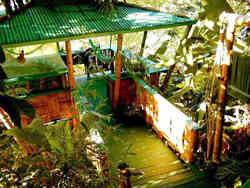A Path to Ecotectural Awareness
|
The Sheer's original Hooch
in Puerto Rico. |
The evolution of current architectural philosophy towards sustainability, and the concomitant attention to energy efficiency, resource recycling, and habitability is often attributed to the effect of major issues pressing upon the conceptual evolution of heavy-duty architectural thinkers. However, a much more eclectic group often initiates the conceptual tenets of earth-friendly design. Architectural Outlaws, those freewheeling, construction-savvy gurdians of the great designer-builder tradition, are the true source of creativity that feeds the evolution of new design trends. It is the innovation of this fiercely independent and self-sufficient group that converts concepts to working, real-world applications. Although not all the innovations of this latter group are adapted, local resource availability, personal preference and the infinite potential of ideas insures a diversity of design possibilities. Although a specific design may not be applicable to other climates, locations, or personal preference, a general trend emerges. Thus, individual innovation is the engine of change, and a rainbow of ideas is coalesced into one bright light.
I like to think of myself as a design outlaw. I certainly have a predilection for ideas, and I do manage to actually apply them in real life. As I examine my path to eco-tectural awareness, however, it becomes clear that, had I not pursued a concept, the intricacies and epiphanal episodes in the pursuit of that concept would not have occurred. You can never anticipate where a path may lead. It is in the act of taking that path that it is revealed. The ultimate destination may not be what you anticipated. It is but a consequence of what was learned along the path.
My path to an eco-tectural awareness has certainly meandered, and has been punctuated with a plethora of side paths, roads, and unanticipated consequences. Having completed the trek thus far (it is far from over), it becomes clear that it has coincided with the paths of many others, each manifested in the belief that living lightly on this earth is a moral imperative. How this is achieved, on a personal level, is as individual as each of us.
The energy crisis of 1973, though engineered by false economics, was a wake up call to the big picture of an oil-dependent economy based on consumption, inefficiency, and resultant serious detrimental environmental consequences. As an impressionable student at the University of Wisconsin, I was moved by my emerging awareness to abandon my uninspiring pharmacy major, and investigate the burgeoning field of alternative energy and solar-based architecture. A friend and I formed Sunrise Enterprise, a construction venture specializing in passive solar remodeling and design.
|
The entrance from above |
As we immersed ourselves in the economics of providing heat for a dwelling, through relatively expensive, but really cool solar techniques, it became clear that the most cost effective way of reducing fossil fuel consumption and making alternative energy applications viable, was conservation. Not very sexy, but a simple solution to the demise of cheap energy.
The economics of fuel and personal wanderlust dictated a move to a warmer climate where there is no need for heating fuel. My calculations on a cold and late winters' evening revealed a remarkable truth: that a winters' worth of fuel was equivalent to the cost of a plane ticket to a climate that did not need to burn fuel to keep warm. Thus, I rationalized my move to the Caribbean, and never looked back. The laid back, barefoot lifestyle of the islands appealed to me, and I stayed. Acquiring a sailboat, I embraced the roving life. I could travel from island to island with the power of the wind and sun, my sails catching the wind and a pair of photo-voltaic panels off the transom catching the sun. I had achieved energy independence, island style.
An interest in natural materials led to a fascination with the multiple applications of coconut palm, and eventually to bamboo. My occupation of building with square wood evolved into a specialization in and notoriety for designing interiors using round bamboo and palm, and an unflagging interest in bamboo. The more I worked and played with bamboo, the more I learned about it. Further research revealed the huge world of bamboo, and the long and intimate relationship man has had with it, mostly in the East. David Farrellys' The Book of Bamboo, became my bible. The economic, ecological, structural and aesthetic qualities of bamboo were impressed upon me, and my enthusiasm for it has only grown stronger with time.
Before long, I was sharing my idyllic lifestyle with a growing family. My son adapted well to life on the boat, but soon a daughter was to be, so it was agreed to move back to land. Our desire to get back to land and nature led to the purchase of 12 acres on the West coast of Puerto Rico in the small surfing community of Rincon'. On the crumbling ruins of an old farm house, I built our home. On the fallow, former sugar cane plantation, I planted bamboo, bananas, and fruit trees, with a vague notion of establishing a permaculture-style rejuvenation of the land. I planted over 25 species of bamboo, and incorporated bamboo throughout our home as furniture, interior accessories and integral architectural accents.
NEXT >>

